People First: How To Plan Events Everyone Can Attend
- "People First: How to Plan Events Everyone Can Attend" is also available as a PDF (PDF, 303KB, 13pg.)
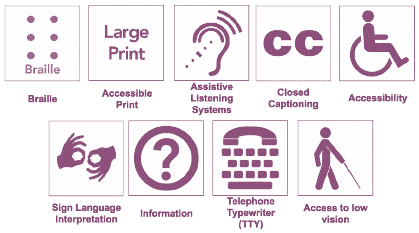
This publication provides tips on planning meetings, conferences, health fairs and other events in which everyone can participate. Even when you may not know in advance whether any of your participants may need accommodations, you should be prepared to:
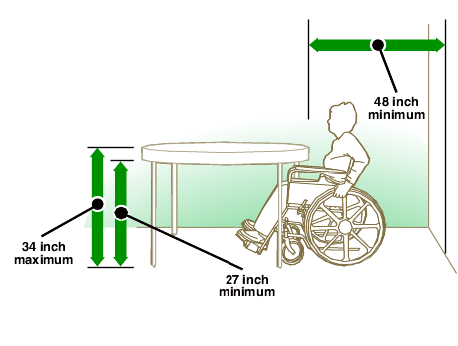 Arrange meetings and events at accessible locations where people with disabilities can participate without assistance, or with minimal help.
Arrange meetings and events at accessible locations where people with disabilities can participate without assistance, or with minimal help.- Conduct an on-site visit to evaluate the facility's restaurant, bedrooms, bathrooms, meeting rooms, signs (both Braille and tactile), as well as parking options. Even when a facility says it complies with the Americans with Disabilities Act (ADA), you need to check so that there are no last-minute surprises.
- Offer materials and presentations in alternative formats, such as Braille, tapes, computer disk, closed caption, and large print. Inquire about preferred format in your registration material. Also inquire about the need for sign language interpreters.
- Make modifications to the physical environment, such as rearranging furniture.
- Create event-planning policies that support accessibility.
Why do public events need to be accessible?
It's the law. The 1990 Americans with Disabilities Act (ADA) and New York State public meeting laws protect the right of people with disabilities to participate in public events. The law stresses reasonable accomodations, as well as the provision of auxiliary aides and services. It's also simply good business practice, and can be inexpensive.
What are disabilities?
Disabilities are physical and mental impairments that limit at least one major life activity, such as walking or seeing. Disabilities present themselves in many forms. Some disabilities are visible; others, invisible. They may be permanent or temporary; developmental or physical; severe or mild; or any combination of impairments. A person can be young or old, be born with a disability, or acquire a disability as a result of an injury or chronic illness.
Approximately 20 percent of Americans have disabilities, and one in five Americans will develop a disabling condition in his or her lifetime.
Since you may not know who will attend your event, you must plan for everyone.
Who's responsible for the accessible meeting?
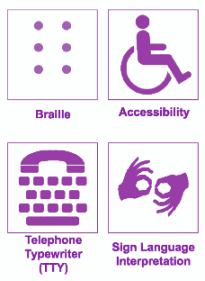 Facility staff are legally responsible for ensuring the site is in compliance with the ADA. But the event planner has a responsibility to schedule meetings and events only at sites or facilities that are accessible and barrier-free.
Facility staff are legally responsible for ensuring the site is in compliance with the ADA. But the event planner has a responsibility to schedule meetings and events only at sites or facilities that are accessible and barrier-free.
To ensure that you're using facilities with accessible environments, make an on-site visit and evaluate the physical environment. For this purpose, the U.S. Department of Justice publishes "Checklist for Readily Accessible Achievable Barrier Removal." For a free copy, call 1-800-949-4ADA, or download the text from www.usdoj.gov/crt/ada/checktxt.htm.
For information on accessibility, you can also call the New York State Commission on Quality of Care and Advocacy for Persons with Disabilities at 1-800-522-4369 (voice/TTY) or at www.cqcapd.state.ny.us .
How do I plan an accessible meeting?
Start by developing a policy that documents your group's positive attitude toward accessible events. For example, your policy should state that your organization will hold events only at facilities that have been determined to be accessible. Using a survey, such as the Justice Department's checklist, shows your agency's good faith effort to include everyone in your events.
What are the benefits of a written policy?
A policy:- Shows that your organization welcomes everyone.
- Sets directions for your organization planners.
- Helps your organization be prepared.
Sometimes, you may need to take action to meet an immediate need. For example, you are working with a facility that does not have Braille signs. The facility cannot acquire permanent Braille signs before your scheduled event. However, it does offer to place temporary Braille signs in the area of your meeting space and agrees to install permanent Braille signs before your next event. This accommodation will meet the immediate need and lays the ground work for the facility improving its accessibility.
What does "accessible accommodation" mean?
The following examples are from the "Checklist for Readily Achievable Barrier Removal" and the Rehabilitation Engineering and Assistive Technology Society of North America (RESNA) (www.resna.org).)
- Choose facilities near accessible transit options. If the event is to be held over several days, evaluate the accessibility of local restaurants, movie theaters, and shopping malls that participants may want to visit.
- Plan for 30 percent more meeting space when 10 percent or more of the participants will use mobility aids.
- On the registration form, ask participants to indicate their need for accommodations.
- Always check out the facility. Use check lists provided in this booklet's resources, and enlist the help from a local Center for Independence. www.ilny.org/index.asp
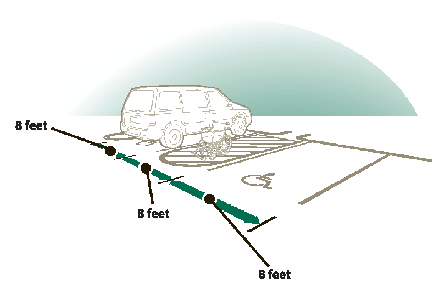
Look for accessible parking. Parking stripes should allow 8 feet for a car/van plus a 96 inch access aisle. The access aisle should be marked with a "No Parking" sign. The accessible spaces should be closest to the accessible entrance, and there should be signs indicating accessible parking. To ensure that only those in need of these parking spaces use them, there should also be an enforcement policy.
The facility should ensure that doors are a 32-inch minimum width to allow a wheelchair to pass. If not, the facility can widen doors or install offset (swing-clear) hinges. There should also be 18 inches of clear wall space on the pull side of the door, next to the handle. If not, the facility can relocate furniture or remove the obstruction, move the door or add a power-assisted or automatic door opener. Check for hazards that will cause people to trip, and have the facility fix them. Have the facility remove mats and patch holes in the pavement.
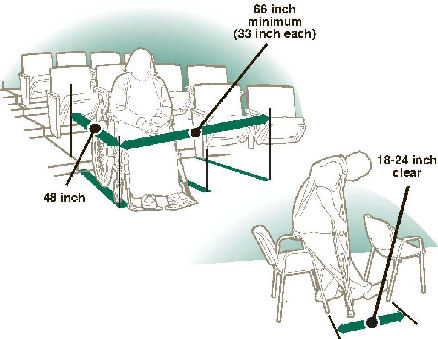 Check seating options so people with disabilities are not limited to the back or front of the room. Most standard tables can comfortably accommodate wheelchairs.
Check seating options so people with disabilities are not limited to the back or front of the room. Most standard tables can comfortably accommodate wheelchairs.- Ensure that both registration and conference materials are accessible.
- Ask about accommodation needs in your registration form.
Sample registration questions
I will need the following accommodations in order to participate:
 ASL Interpreter
ASL Interpreter Note taker
Note taker Open captioning
Open captioning Large print
Large print Braille
Braille Audio cassette
Audio cassette Wheelchair access
Wheelchair access Assistive listening device
Assistive listening device Disk (format):
Disk (format): Special diet.
Special diet.- An assistant will be accompanying me.
 Yes
Yes  No
No
- Make sure registration staff are aware of accessible places and materials for the conference.
Accessible Materials
To ease communication barriers, the presenter can::
- Put conference materials in binders for easy page turning.
- Create easy-to-read visual aids. Text should be displayed in large bold letters. Eight lines of text (18-point type with high contrast) are maximum for a slide or transparency.
- Talk clearly and slowly, spell out unusual names and words for a sign language interpreter, and use closed-captioned films and videos.
- Use microphones and face the audience when speaking to assist those who read lips or use assistive listening devices.
- Inquire about Computer-Assisted Realtime Translation (CART). A court reporter/stenocaptioner enters the speaker's words into a computer that displays them as text for the participant. The National Court Reporters Association at 1-800-272-6272 www.ncraonline.org maintains a list of certified realtime reporters.
A Final Note
Being prepared can help you handle the unexpected. Use this information to help avoid and rectify common problems. By working together with the facility's staff, as well as people who need accommodations, you can help ensure that people of all abilities will be able to participate in your event.
For more information on planning accessible meetings, specific dimensions and layouts, preparing alternate formats, sample letters and check lists, consult these sources:
"A Guide to Planning Accessible Meetings," by June Kailes and Darrell Jones, www.jik.com/gpam.html
Removing Barriers: Planning meetings that are accessible to all participants. North Carolina Office on Disability and Health. www.fpg.unc.edu/~ncodh/removingbarriers
Accommodations Check List:
| Parking and Pathways | |
|---|---|
| Are there accessible parking spaces near the accessible entrance? Are spaces clearly marked with the international symbol of accessibility? Are the spaces and access aisles 8 feet wide? Are the access aisles marked with "No Parking" signs? | |
| Is there an accessible route from parking/drop-off to the entrance? Is sidewalk a minimum of 36 inches wide at all points? | |
| Entrance and doors | |
| Does entrance door have opening of at least 32 inches of clear width? | |
| Do non-accessible entrances have signs giving directions to the accessible entrance? Is there an automatic door? Or, is pull force on door five pounds or less? | |
| Public Areas | |
| Does registration area have a lowered counter? | |
| Is there a text telephone (TTY)? | |
| Are all accessible routes free of protruding objects? | |
| Are all elevator call buttons located at 42 inches or below? Is there raised letter and Braille signage on door jams designating each floor? | |
| Public restrooms | |
| Are restrooms located along an accessible route of travel? | |
| Does signage at inaccessible rest rooms direct people to accessible restrooms? | |
| Does door to restroom provide a minimum of 32 inches of clear opening width? | |
| Does restroom have levered handles? | |
| Does stall have adequate manuerving space? (30 to 36 inches clearance front and side of toilet.) Is toilet seat 17 to 19 inches above floor? Are there appropriate grab bars? | |
| Does lavatory provide knee clearance of 29 inches? Are soap, towels and amenities located at or below 48 inches? | |
| Meeting rooms | |
| Are meeting rooms on accessible route of travel? | |
| Do doors provide at least 32 inches clear width? | |
| Does stage have an accessible ramp? | |
| Is there an assistive listening system available? | |
| Does room have movable seating? | |
| Emergency | |
| Are exits clearly identified and accessible? | |
| Do fire and emergency alarms have both audible and visual signals? | |
| Other facility areas to check if needed for your conference or for participants' free time | |
| Sleeping rooms | |
| Recreation rooms | |
| Restaurants | |
| Vending machines | |
| Retail stores and services | |
"People First" is a health and wellness series for people with disabilities, their families, friends and health care providers. It is provided by the Disability and Health Program.
Disability Access Symbols are courtesy of Graphic Artists Guild Foundation.
To downlink and use them free-of-charge, link to /www.gag.org/
New York State Department of Health